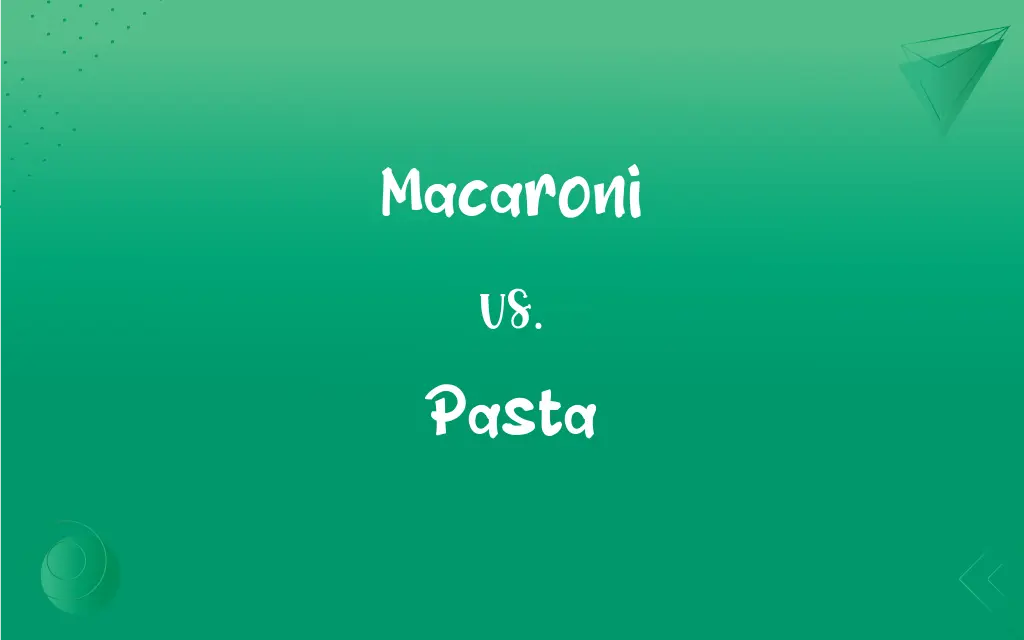Macaroni vs. Pasta: What's the Difference?
Edited by Aimie Carlson || By Harlon Moss || Updated on October 14, 2023
Macaroni refers to a specific type of pasta with a narrow, tubular shape, while pasta is a general term for Italian-origin noodles made from wheat and water. Both are staples in various cuisines and known for their versatility.

Key Differences
In the sphere of culinary arts, pasta stands out as a quintessential ingredient in Italian cuisine, revered for its adaptability and wide range. Conversely, macaroni holds its place as a specific kind of pasta, recognized globally for its tubular shape and prominent role in certain dishes. Both pasta and macaroni grace our plates in numerous preparations, embedding themselves in our culinary experiences with their diverse applications.
When considering the vast world of pasta, it spans various shapes, sizes, and types, including spaghetti, penne, and fettuccine, to name just a few. Macaroni, with its small, elbow-like shape, is confined to a singular structural identity, but nonetheless appears in numerous cuisines and dishes. Both items navigate through the culinary world, one as a broad category and the other as a specified entity, delivering a plethora of flavors and textures to explore.
Pasta, in its myriad of forms, can be either fresh or dried and is often made from a simple dough of wheat and water. Macaroni, however, is typically available in dried form and is synonymous with comfort foods like macaroni and cheese. Despite pasta's broad applications and macaroni's more comfort-oriented utilization, both find common ground in being beloved staples within and beyond Italian cuisine.
Exploring global dishes, pasta finds itself at home in a wealth of recipes, from the Italian Bolognese to Asian stir-fries. Macaroni too, despite its specificity, journeys through various culinary landscapes, becoming a vital ingredient in salads, casseroles, and soups. Both pasta and macaroni, with their respective spectrums of application, enrich our dining experiences with a balance of familiarity and novelty.
Regarding preparation methods, pasta's versatility shines through, being boiled, baked, or even stir-fried across various cuisines. Macaroni, while mostly boiled, also enjoys a range of preparations, notably being baked in rich, cheesy dishes or tossed in cool, creamy salads. Both pasta and macaroni, while distinct in identity, convene in their ability to be manipulated across cooking methods, crafting dishes that comfort and excite palates globally.
ADVERTISEMENT
Comparison Chart
Word Length
8 letters
5 letters
Syllables
4 syllables
2 syllables
First Letter
M
P
Vowels
4 vowels
2 vowels
Common Use in Cuisine
Typically Western dishes
Used globally across many cuisines
ADVERTISEMENT
Macaroni and Pasta Definitions
Macaroni
Macaroni is a type of pasta shaped into narrow tubes.
I cooked macaroni and cheese for a comforting weekend meal.
Pasta
Pasta comes in various shapes and sizes, suitable for different sauces.
For the seafood dish, she chose a thin pasta that wouldn't overpower the delicate flavors.
Macaroni
Macaroni is commonly utilized in American and British comfort foods.
For dinner, we enjoyed a creamy macaroni and cheeseburger casserole.
Pasta
Pasta can be freshly made at home or bought in dried forms.
He prefers using fresh pasta for his homemade lasagna to enhance its texture.
Macaroni
Macaroni often refers to elbow-shaped pasta used in various dishes.
My salad was a hit, thanks to the addition of chilled macaroni.
Pasta
Pasta is often boiled but can also be baked or used in stir-fries.
The pasta was baked to perfection with a crispy, golden-brown cheese topping.
Macaroni
Macaroni is typically made from durum wheat and water, formed into tubes.
The macaroni retained its shape well, even after being boiled and baked.
Pasta
Pasta serves as a base in many dishes, embracing diverse ingredients and sauces.
The pasta absorbed the rich, hearty Bolognese sauce, making every bite a delight.
Macaroni
Macaroni can be used in baked dishes, often combined with cheese.
The baked macaroni casserole was a perfect dish for the potluck.
Pasta
Pasta is a staple Italian dish made from wheat and water.
She made a delicious bowl of pasta with fresh basil and tomatoes.
Macaroni
Pl. macaroni Pasta in any of various hollow shapes, especially short curved tubes.
Pasta
Unleavened dough, made with wheat or other flour, water, and sometimes eggs, that is molded into any of a variety of shapes and boiled.
Macaroni
A well-traveled young Englishman of the 1700s and 1800s who affected foreign customs and manners.
FAQs
What is a popular dish that prominently features macaroni?
Macaroni and cheese is a popular dish that predominantly features macaroni.
Can pasta be made from grains other than wheat?
Yes, pasta can be made from other grains like rice, quinoa, or corn to accommodate dietary needs.
What is the primary ingredient in pasta?
Pasta is primarily made from wheat flour and water, sometimes with added eggs.
How is macaroni typically shaped?
Macaroni is commonly shaped into small, curved tubes, often referred to as "elbows."
Is pasta generally considered a healthy food?
Pasta can be part of a healthy diet when paired with nutritious ingredients and consumed in moderation.
Can pasta be gluten-free?
Yes, gluten-free pasta options are available, typically made from rice, corn, or other gluten-free grains.
Can macaroni be made at home?
Yes, homemade macaroni can be made with a pasta machine or by hand-rolling and cutting.
How long does uncooked macaroni generally last?
Uncooked macaroni, stored properly, can last up to two years past its expiration date.
Is macaroni a type of pasta?
Yes, macaroni is a specific type of pasta, known for its short, tubular shape.
Can pasta be frozen after cooking?
Yes, cooked pasta can be frozen and should be used within one to two months for optimal quality.
How is pasta typically cooked?
Pasta is typically boiled in salted water until it reaches the desired level of doneness.
Can macaroni be made from whole wheat?
Yes, macaroni can be made from whole wheat for a fiber-rich alternative.
How should leftover cooked pasta be stored?
Cooked pasta should be stored in an airtight container in the refrigerator for up to five days.
Is macaroni available in gluten-free varieties?
Yes, gluten-free macaroni is available and is often made from rice or corn flour.
Can pasta be cooked in a microwave?
Yes, pasta can be cooked in a microwave using a microwave-safe bowl and plenty of water.
What are the nutritional contents of macaroni?
Macaroni contains carbohydrates, protein, and small amounts of various vitamins and minerals, with exact contents varying by brand.
What is a serving size of pasta?
A standard serving size of cooked pasta is typically about one cup.
Can macaroni be used in cold dishes?
Yes, macaroni is often used in cold pasta salads with various vegetables and dressings.
Is macaroni and cheese always made with elbow macaroni?
While elbow macaroni is traditional, any pasta shape can be used to make macaroni and cheese.
What are some common types of pasta?
Common pasta types include spaghetti, penne, fettuccine, and linguine, among others.
About Author
Written by
Harlon MossHarlon is a seasoned quality moderator and accomplished content writer for Difference Wiki. An alumnus of the prestigious University of California, he earned his degree in Computer Science. Leveraging his academic background, Harlon brings a meticulous and informed perspective to his work, ensuring content accuracy and excellence.
Edited by
Aimie CarlsonAimie Carlson, holding a master's degree in English literature, is a fervent English language enthusiast. She lends her writing talents to Difference Wiki, a prominent website that specializes in comparisons, offering readers insightful analyses that both captivate and inform.































































